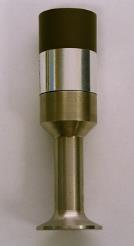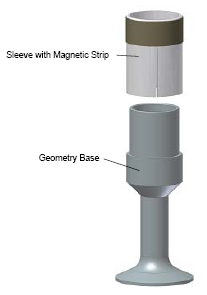
| Overview |
Smart Swap™ geometries are an extension of the Smart Swap technology. These geometries can be automatically identified when installed on the DHR or AR-G2 Rheometer. (Note: This option is not available for the AR 2000ex or AR 1500ex.) The magnetic strip on the head of each geometry provides the information that will uniquely identify it to the instrument. These geometries are resistant to changes in temperature and the use of solvents and do not interfere with your experiment in any way.

The Smart Swap geometries have a larger diameter than previous geometries, which is required to record sufficient data (36 bits) around the circumference. In addition, the geometries have a larger bore to allow a better location surface and easier cleaning.
Each geometry has a unique six-digit serial number for identification purposes. When the geometry is set up for the first time this number is encoded into the magnetic strip and a link is established to a geometry file in the instrument control software. The geometry then becomes "Smart."
When a Smart Swap Geometry is attached to the rheometer, a sensor registers the attachment and slowly spins the shaft to read the serial number from the magnetic strip. The geometry file associated with this serial number is then loaded by the software.

The Environmental Test Chamber (ETC) geometries, with the exception of disposable plates, are available with the Smart Swap technology.
Previous AR Peltier geometries (with a narrow bore) can be used with a smart adapter. You will be given a list of all standard geometries in the database when the adapter is identified.
For detailed information related to the Smart Swap geometries, refer to the AR Series Operator's Manual or the DHR Getting Started Guide.